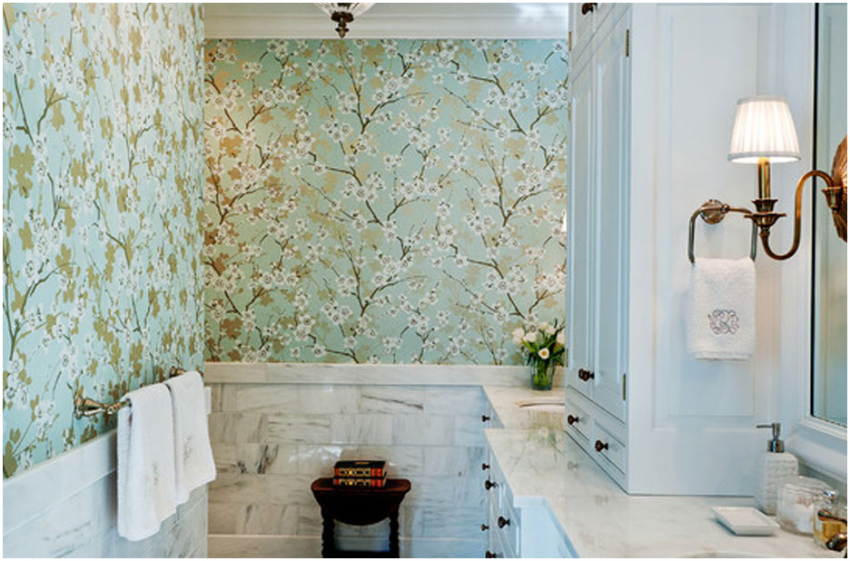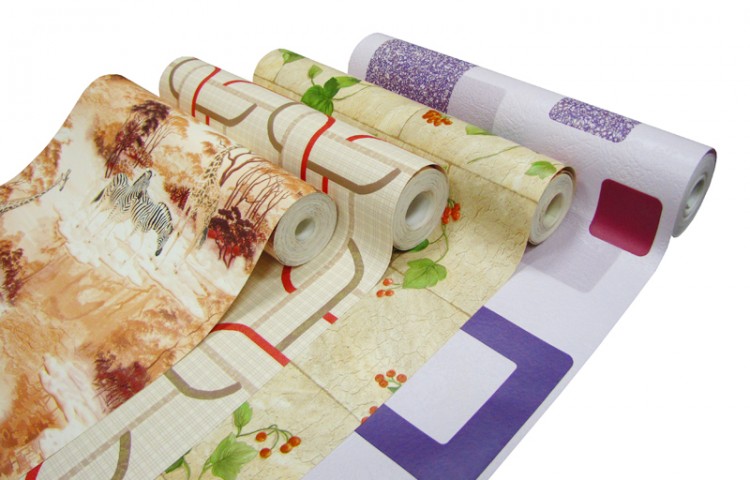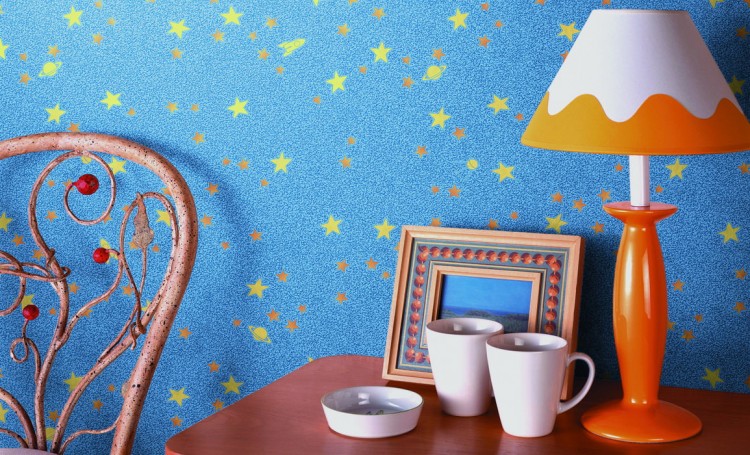Vinyl wallpaper - the secrets of choice
The choice of wallpaper is a very important decision in the process of any renovation. Someone likes to glue "for centuries" and chooses materials that can maintain a spectacular look for 8-10 years, someone, on the contrary, prefers to change the look of the walls every 2-3 years.
The necessary price-quality ratio, interesting color and all kinds of patterns, moisture resistance, the ability to survive scratches, bumps and children's drawings - the ideal wallpaper must meet all these qualities. For this reason, representatives of various segments of the population are increasingly choosing vinyl wallpaper for walls.
This type of wallpaper has a beautiful, rich pattern.
The main advantages of vinyl wallpaper
Vinyl wallpaper is a special type of wall covering in the form of rolls with a base of cheap paper or more expensive and prestigious interlining. Above - a layer of polyvinyl chloride (popularly - vinyl) of different thicknesses, structures and volumes.
In the huge mass of vinyl wall coverings, there are many subspecies, but they all have common advantages, thanks to which they are loved by buyers.
- Strength.
Unlike inexpensive and popular paper wallpapers, vinyl coating has 2 layers: paper / interlining + vinyl film, so they are much stronger. It is almost impossible to tear a piece of such a roll, for example, when gluing. - Durability.
Wallpapers with a vinyl layer are champions in wear resistance: such a coating can stay on the walls for up to 10 years, retaining the original color and freshness of colors even with wet cleaning. The only problem is that bright vinyl patterns can simply get boring. - Moisture resistance.
Depending on the type of vinyl wallpaper in the interior, they can be wiped with a wet cloth, fully washed and even rubbed with a brush or sponge. You just need to choose the necessary marking - and the walls will be able to survive the cleaning of any intensity. - Versatility.
Perhaps the main advantage of this coating is that vinyl wallpaper in the interior can be matched to any style. The vinyl layer is able to imitate velvet, fabric, textured plaster, stone, brick, bamboo, wood and other materials. In addition, the choice of colors and all kinds of patterns on vinyl is simply amazing - such a wealth of colors cannot be found among paper, non-woven or textile wallpapers.
This allows you to choose a two-layer wall covering for houses and apartments decorated in any style: strict classics, elegant retro, cozy country, laconic high-tech, industrial loft and others.

Wallpaper with a washable layer can be used for pasting the bathroom
Disadvantages of vinyl wallpaper
With all its advantages, PVC building materials have a number of disadvantages, which, nevertheless, can always be corrected.
- Toxicity.
Although there have already been a lot of various “test purchases” and studies on the dangers of PVC, the debate about whether vinyl wallpaper is harmful does not subside.
Indeed, low-quality chemical material, when combined with wallpaper glue, can emit formaldehyde vapors for up to 4 years, but only cheap wallpaper of dubious quality is guilty of this. If you choose the “clothes” for your walls correctly and scrupulously, this trouble can be avoided. - Airtight.
Another complaint about trendy wallpapers is the inability to let air through. Heavy vinyl covers the wall very tightly, leaving it no room to breathe, but it creates a humid environment - a convenient place for the growth of fungi and harmful microorganisms. It is also possible to solve such a problem if you choose non-woven vinyl wallpaper - modern material, unlike paper, passes air much more freely. - Problem repair.
In the absence of experience in gluing heavy two-layer wallpaper, noticeable difficulties may arise. So, paper-based vinyl wallpaper can shrink when dried, resulting in noticeable gaps between the pasted strips. Vinyl must be glued strictly end-to-end (by no means overlapped!), which does not always work out perfectly, especially with a complex pattern on the canvas and uneven walls.
The solution is in non-woven vinyl wallpaper. Such canvases weigh less, it is more convenient to hold them in your hands during repairs, and the glue needs to be smeared on the wall, and not on the roll, which also facilitates the workflow. - Price.
The high cost of vinyl rolls is one of the reasons why people choose the more affordable paper rolls. However, the high price tag is successfully compensated for by a long service life and resistance to mechanical stress, dirt and wet cleaning.

Air tightness is a minus of this type of wallpaper. Moisture resistance is a plus.
Varieties of vinyl wallpaper
On the net you can find many different classifications of vinyl canvas, but there are only 5 main types of such wallpaper.
Structural with a layer of foamed vinyl
Such a coating has a voluminous loose structure of various colors and patterns, often with sparkles, which are interspersed in the top layer of the lush canvas.
This variety is ideal for rooms with uneven walls. If there are cracks, bulges and small pits on the surface, the volumetric coating will smooth out all the bumps and create an interesting play of light on the foam surface. Such vinyl is also used for pasting surfaces made of wood, plywood, fiberboard. In addition, fashionable vinyl wallpaper for painting is also a foamed canvas.
It is necessary to paint vinyl wallpaper with caution, first of all, be sure to check with a specialist in the store if this type is suitable for painting. For structural vinyl wallpaper for painting, water-based paint and a roller are usually advised, before the process - a primer in two layers. The color of the walls can be changed as often as you like until the foam texture starts to smooth out on the wallpaper.
Vinyl wallpaper hot stamping. This group distinguishes between heavy and compact vinyl.
Heavy vinyl is the densest canvas of interesting deep colors and patterns. Such wallpapers hide the unevenness of the walls well, but they are quite difficult to glue, and a thick two-layer coating hardly lets air through and can be the cause of fungus on the walls.
Compact vinyl is just a dream for designers: it is the rolls with this canvas that are made as an imitation of various surfaces: textiles, wood, brick, they are very durable, withstand almost any mechanical impact and retain their spectacular appearance for many years.
Sometimes hot embossed wallpaper refers to vinyl with chemical embossing. Such a canvas is particularly resistant to ultraviolet radiation, practically does not fade in direct sunlight and is in excellent contact with moisture without damage.

Wallpaper of this type consists, in fact, of three layers
Silkscreen - the most beautiful type of vinyl
Such vinyl wallpapers are always on a paper basis, silk threads are woven into the top layer, which create a unique noble effect. "Silk" wallpaper can be smooth and embossed, very rich in color, on the walls it looks invariably luxurious and expensive. These wallpapers are very durable, resistant to water and abrasion, can retain their bright color and shine for up to 8-10 years. Best of all, such a coating looks on the walls in the corridors, both narrow and wide, bedrooms and large living rooms.
Washable vinyl wallpaper (or polyplene)
Washable flooring is a great way to decorate walls in a kitchen, bathroom or nursery where regular cleaning is required or where walls come into frequent contact with liquid. The wallpaper can have a smooth and foamed surface, several layers are applied on top of the base: polyvinyl chloride, plasticizers, stabilizers, pigments and various other additives.
Hard, or vaporized, vinyl
This variety is gaining more and more popularity today - it is such wallpaper vinyl that is recognized as hypoallergenic and environmentally friendly. The fabric is based on three layers of paper and evaporated polyvinyl chloride, from which all harmful substances that can further evaporate are removed.
Wallpaper based on a hard vinyl layer has a quality certificate of the European independent environmental assessment, which means that they can be safely used to renovate children's bedrooms and one-room apartments in which babies live.

Wallpaper with a layer of PVC often have very bright, cheerful shades.
How to choose vinyl wallpaper?
When choosing materials for repairs, it is often difficult for us to decide which vinyl wallpaper is better. First you need to decide where exactly you want to make spectacular walls from a fashionable coating.
For the bathroom and kitchen, the choice is unequivocal - it is polyplen. Washable vinyl wallpapers are best chosen by the marking icon, usually a marine symbol: one wave - the canvas is moisture resistant, can be wiped with a damp cloth; two and three are washable; wave and comb - vinyl is washed with a brush (sponge).
If you like plain walls, plan to change the color of the wallpaper as often as possible, or renovate a nursery where a little artist lives, it is better to buy embossed foam rolls for painting.
The covering for bedrooms should be chosen "breathable", and this is vinyl wallpaper on non-woven fabric. The paper base does not allow air to pass through, so silk-screen printing and heavy vinyl are best left for corridors and halls.
Important:
The safest vinyl wallpaper on non-woven is a perforated canvas, and small holes must be “pierced” through, in both layers. Finding them is quite easy - just look at the rolls you like in the store to the light - micropores are very clearly visible.
To decide which vinyl wallpaper is better, you can also navigate by smell. Be sure to smell the chosen canvas - in no case should the roll smell like acetone. Another dangerous signal is if the top layer is oily to the touch. Proper vinyl should be dry, like textured vinyl.
When planning repairs, many people ask themselves one more question - is it better to choose non-woven or vinyl wallpaper for the interior? Each of these varieties has its own advantages: vinyl is very durable, has a wide selection of colors and patterns, and is easy to clean. But interlining is also durable, allows the walls to breathe, is used for painting - up to 12 layers of paint can be applied to the surface pasted over with it. Non-woven wallpaper is also very easy to glue: the solution needs to be applied only to the wall, air bubbles do not form under the light canvas. After drying, the wallpaper does not change shape, so they are recommended for repairs in "freshly built" houses, which usually shrink. The choice of whether to purchase vinyl or non-woven wallpaper for renovation also depends on the type of room. Interlining does not tolerate moisture well, so smooth vinyl should be preferred in the bathroom or in the kitchen.
Vinyl wallpaper is a huge selection of wall coverings of different structure, color and even composition. Buying the perfect decoration for each of the rooms in your home is not difficult, you just have to carefully study the features of each type of vinyl sheet and choose the right one.
